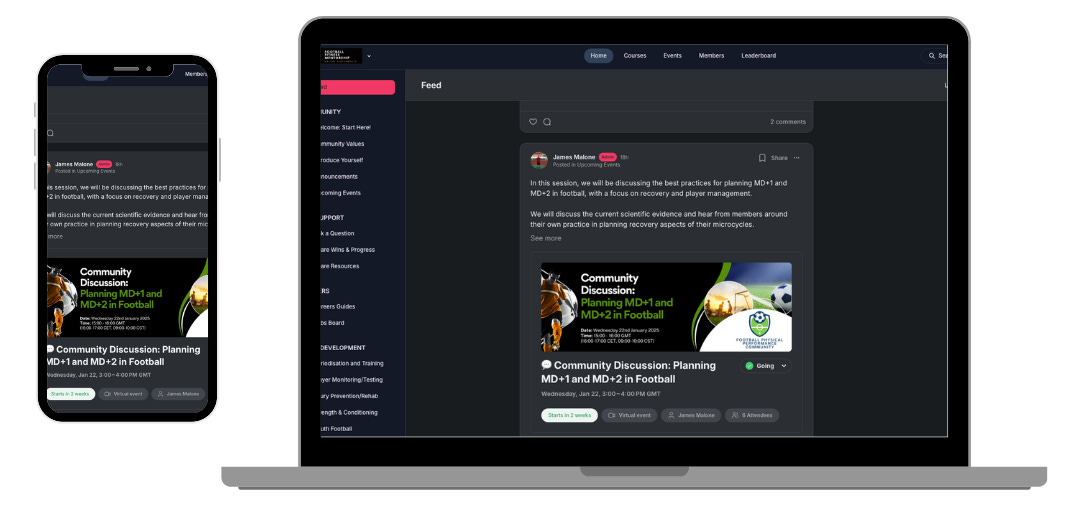How to Structure Off-Season Training for Players
The season’s done. Players are on holiday, WhatsApp groups have gone quiet, and the coaching staff finally has time to breathe.
But for physical performance coaches, the off-season isn’t just downtime—it’s a window. A short but critical opportunity to help players rest, rebuild, and return ready.
So how do you plan an effective off-season for footballers? Let’s break it down.
Physiological Impact of the Off-Season
As you can imagine, reduction in training load will result in a reduction in physical qualities for footballers.
This excellent paper by Joao Silva and colleagues highlights the issues very well:
- Small increases in body fat and reductions in lean mass are typical.
- Moderate declines in sprint performance and muscle power.
- Large reductions in VO₂max, time to exhaustion, and Yo-Yo test performance.
Despite these issues, the authors suggest that as little as two sessions per week in the off-season can preserve neuromuscular and aerobic fitness.
The Purpose of the Off-Season
The best off-season programmes do three things:
Help players recover—physically and mentally—from the cumulative load of the season.
Prevent deconditioning, especially aerobic capacity, strength, and movement quality.
Prepare players for pre-season, so they can hit the ground running and reduce injury risk.
And here’s the nuance: not every player needs the same thing.
A player who played 3,500 minutes will need more rest than one who played 500. A winger who struggled with repeat sprint ability might benefit from targeted exposure. A returning-from-injury player may need a more rehab-based approach.
So while templates are useful, individualisation is critical.
Three Phases That Work
Typically off-season can be broken down into three informal phases. The exact duration depends on how long the player has off, but a 6-week plan often looks like this:
1. Recovery (Week 1–2)
Full rest or very low-load activity.
Focus on sleep, nutrition, and stress reduction.
Think hiking, swimming, light yoga—not heavy sessions.
This phase is essential. It allows the body to recalibrate after months of accumulated fatigue.
2. Rebuild (Week 3–4)
Gradual reintroduction of general training.
Aerobic conditioning (tempo runs, bike sessions), basic strength (3–4 gym sessions/week), mobility and movement work.
Use this time to address asymmetries or imbalances revealed by end-of-season testing.
This is also where we can chip away at long-term physical goals that in-season constraints never allowed.
3. Preparation (Week 5–6)
Ramp up intensity: high-speed running, accelerations, change of direction, and deceleration exposure.
Return to football-specific movement patterns, technical drills (if possible), and small-sided play.
This final phase is about reintroducing the body to football’s chaos—before pre-season starts doing it for you.
Delivery and Accountability
Off-season plans are only as good as their execution.
Here’s what helps:
Weekly check-ins (even a short voice note or message) to keep players engaged.
Simple monitoring (RPE, HRV, or a quick wellness form) to adjust when needed.
Buy-in through education: explain why this plan matters.
If you’re working remotely with players, apps like Teambuildr, or even a well-designed Excel + WhatsApp setup can do the job.
In recent years, there’s been a noticeable rise in off-season training camps and private performance coaches working with professional players during their break.
On the surface, this can look like a win—players staying active and taking ownership of their development. However, there are several issues that can arise from such approaches.
If the club staff aren’t involved, there may be a disconnect between off-season work and the demands of pre-season.
Some camps focus heavily on aesthetics (body composition, Instagram content) over performance metrics that truly matter for football.
Therefore, if players are working with external coaches, club staff should establish dialogue to align on load, objectives, and timelines.
Bottom Line
Too many players either do minimal during off-season, or do too much too soon. Both lead to problems.
The off-season is short. Use it wisely.
Give players space to breathe—but give them structure too. They’ll thank you when they arrive into pre-season sharper, healthier, and ready to perform.
That's all for today.
See you next Friday.
James 🫡
🚀 Join The Football Performance Network
Take your career in football to the next level by joining a global community of 60+ physical performance practitioners.
As a member, you'll get:
✅ Direct 1:1 mentorship
✅ Weekly live events with industry-leading experts
✅ Practical, high-quality educational content
✅ A supportive network that understands your journey
Whether you're looking to grow your skills, make better decisions in your role, or build your career in elite football, this is the place to do it.
🔗 Join now and start learning, connecting, and progressing — together.
* Limited spaces available




